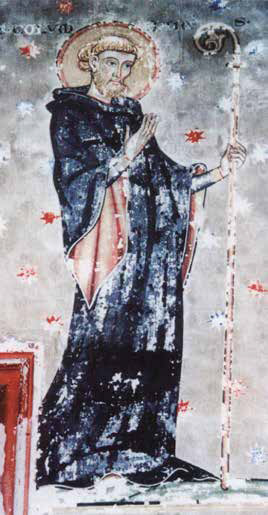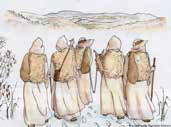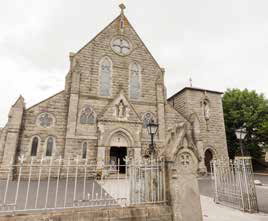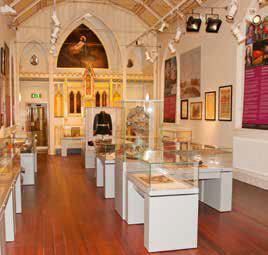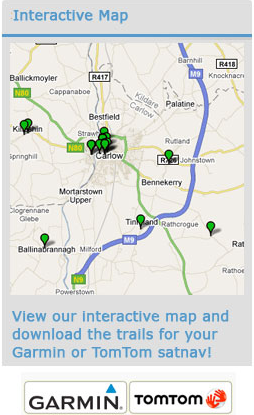Sites
St. Columbanus, Myshall
Myshall has a strong connection to 11 St. Columbanus who, according to his biographer, was born in Leinster and spent his early years there. The border area between Counties Wexford and Carlow and the village of Myshall in particular, have long been believed to have nurtured the saint.
Tradition also holds that Columbanus was advised by St. Croine Bheag, a recluse of Carlow (see St. Patrick’s Trail) to leave home to follow his monastic education. His journey took him from the south to the north of Ireland and eventually to Bangor in Co. Down whose monastery had a close association with Carlow town. From Bangor, Columbanus set off on his great missionary journey to the continent where he founded many monasteries including Luxeuil in France and Bobbio in Italy.
Columbanus was described by Cardinal Tomás Ó Fiaich as ‘Ireland’s first European, a poet, scholar, abbot, preacher and teacher’. He founded monasteries, associated with kings and corresponded with popes. Many of Columbanus’ writings survive and they consistently inspire and encourage.
Plans for a Columban Way (Turas Columbanus) are at an advanced stage. This will link the places visited by the saint on the continent with the sites associated with his early life and education in Ireland. Following in the footsteps of the saint, it will traverse beautiful, peaceful landscapes, stopping at shrines and sacred places and afford opportunities for contemplation and reconnection with social and spiritual values.
A tapestry to honour St. Columbanus was made by local ladies in 2015 to commemorate the 1400th anniversary of the saint’s death and can be viewed in the Church of Exaltation in the village centre.
DID YOU KNOW…
Columbanus was an early exponent of European harmony and unity. He wrote ‘We are all members of one body, whether Franks or Britons or Irish or whatever our race’. As an immigrant in the heart of Europe, he pleaded for toleration and accommodation. His example influenced Robert Schuman, the postwar French foreign minister and architect of the modern European Union.
Relic of St. Willibrord, Carlow Cathedral
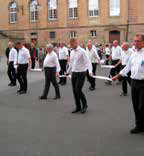
Pilgrims from the Waxweiler and Prum regions of Germany lead the 2017 UNESCO World Heritage Status Hopping Procession through the streets of Echternach, Luxembourg. Photograph: Carlow County Museum.
Inside the cathedral you will find a bronze statue of St. Willibrord, Patron Saint of Luxembourg. It contains a relic of the saint and stands on a stone from the abbey of Echternach in Luxembourg which was founded by him. This relic was gifted to Carlow in 2017 in recognition of Willibrord’s strong connection with the county.
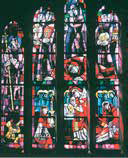
The Irish/Carlow stained glass window in the Basilica of St. Willibrord, Echternach made by Belgian artist, Théodore Hanssen and depicts Willibrord’s training, ordination and first Mass in Co. Carlow.
Originally from Northumbria in England, Willibrord came to Ireland c. 678 to study in the monastery of Rath Melsigi. This monastery, located near Milford in Co. Carlow, was a centre of Anglo-Saxon influence in Ireland and gained an enviable reputation for sanctity and scholarship.
It was from here in 690 that Willibrord led a mission of 12 monks to bring Christianity to Frisia (modern-day Netherlands). This mission was remarkably successful and Willibrord was consecrated Bishop of Utrecht by Pope Sergius 1. He later founded the important abbey of Echternach, Luxembourg, whose scriptorium produced many bibles, psalm-books and prayer-books. Following his death in 739, he was made a saint, and his burial place in Echternach became the focus of devotion to the man known as the ‘First Apostle of the Netherlands’.
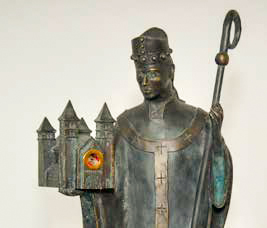
The relic of St. Willibrord is a piece of his bone and is contained within the rose window of the scale model of the Basilica at Echternach which the saint is holding in his right hand. Credit: Thomas Sunderland.
The 1,300-year-old connection between Carlow and Luxembourg was recently rekindled by an ecumenical diocesan pilgrimage from Carlow to Echternach and
the gift of the relic as a ‘thank you’ to the people of county Carlow for training and ordaining Willibrord in the 7th century.
Open
Monday – Friday 7.15am – 7.00pm, Saturday 9.00am – 7.30pm, Sunday 7.45am – 8.00pm
Admission
Free
St. Patrick’s Catholic Church, Rathvilly
In the early medieval period Rathvilly was on the route of one of the five ‘great roads’ believed to radiate out from Tara. The Tripartite Life of St. Patrick records that while the Saint was in Leinster, he converted a local king to Christianity at Raith Bhiligh. The king was called Criomhthann, an ancestor of the Uí Cheinnselaig, who became kings of South Leinster in the seventh century. Criomhthann’s baptism is traditionally believed to have taken place at the holy well dedicated to St. Patrick which is situated close to the town.
Rathvilly today is an attractive small town clustered around the picturesque old bridge and watermill on the River Slaney. St. Patrick’s Catholic Church was designed by William Hague in the late nineteenth century. It was built from granite quarried locally. It is considered a very fine French, gothic-revival building and the interior contains many of the original features. Make sure you find the eye-catching mural depicting the baptism of Criomhthann by the national saint.
LOCATION
St. Mary’s Church of Ireland Church GPS: 52.877167, -6.698113
Directions to the next site
From Rathvilly leave the N81 at Cuckoo Corner onto the R726 for Carlow. At the junction with the R727 turn right. At the junction with the R418 turn right and then immediately left onto the R726. Continue until a left turn signed to Sion Cross. Bennekerry Church is on the left. Distance 16km.
Carlow County Museum
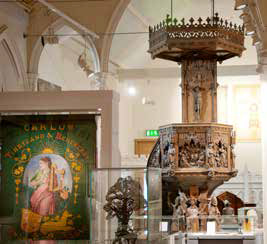
First floor gallery featuring the pulpit from Carlow Cathedral, among top 100 objects to see in a museum in Ireland
Carlow County Museum and Tourist Office is located in the former Presentation Convent, which was founded in 1811 at the junction of Tullow Street and College Street. The Convent remained here until 1989 and the legacy of their education ethos is still present in two of the town’s schools. To the side of the Cathedral of the Assumption the nuns’ graveyard can be viewed.
The Museum, spread over four exhibition galleries gives a snapshot of the archaeology and history of the county and its people. Among the items on display is the famous and magnificent 19th century hand carved pulpit from the next-door Cathedral of the Assumption. The ornate pulpit, standing 6 metres tall, was unveiled in the Cathedral in October 1899. It is the work of Flemish woodcarvers of the Guild of St. Luke the Artist in Bruges, Belgium. The ‘Dr. Comerford Memorial Pulpit’ was commissioned in the late 19th century by the Most Rev. Dr. Foley, Bishop of Kildare and Leighlin in honour of his predecessor. The pulpit has been included in the book A History of Ireland in 100 Objects by Fintan O’Toole, making the pulpit among the top 100 items to view in an Irish museum.
The Museum recalls the county’s important education of St. Willibrord, one of Europe’s most important saints, who after twelve years in the county embarked on his major mission in 690. Today he is the Patron Saint of Luxembourg and the First Apostle of the Netherlands. View a copy of St. Willibrord’s own hand writing, the oldest datable signature of an English person, written on a book from County Carlow. View samples of the beautiful manuscripts that were produced in Echternach.
Carlow County Museum is operated by Carlow County Council in partnership with the Carlow Historical and Archaeological Society (C.H.A.S.). The Museum and Tourist Office is part of a complex that also houses the County Library which has a Local Studies Room and a Genealogy Service.
Open
Admission
Contact
Location
Trail of the Saint’s – Google Maps
ST. PATRICK’S TRAIL:
https://mapsengine.google.com/map/edit?mid=z5TkVYptbfDg.kNdzIgUKoFTE
https://mapsengine.google.com/map/edit?mid=z5TkVYptbfDg.k9UOIum5OUv4
https://mapsengine.google.com/map/edit?mid=z5TkVYptbfDg.kb_MisE9yfHE
